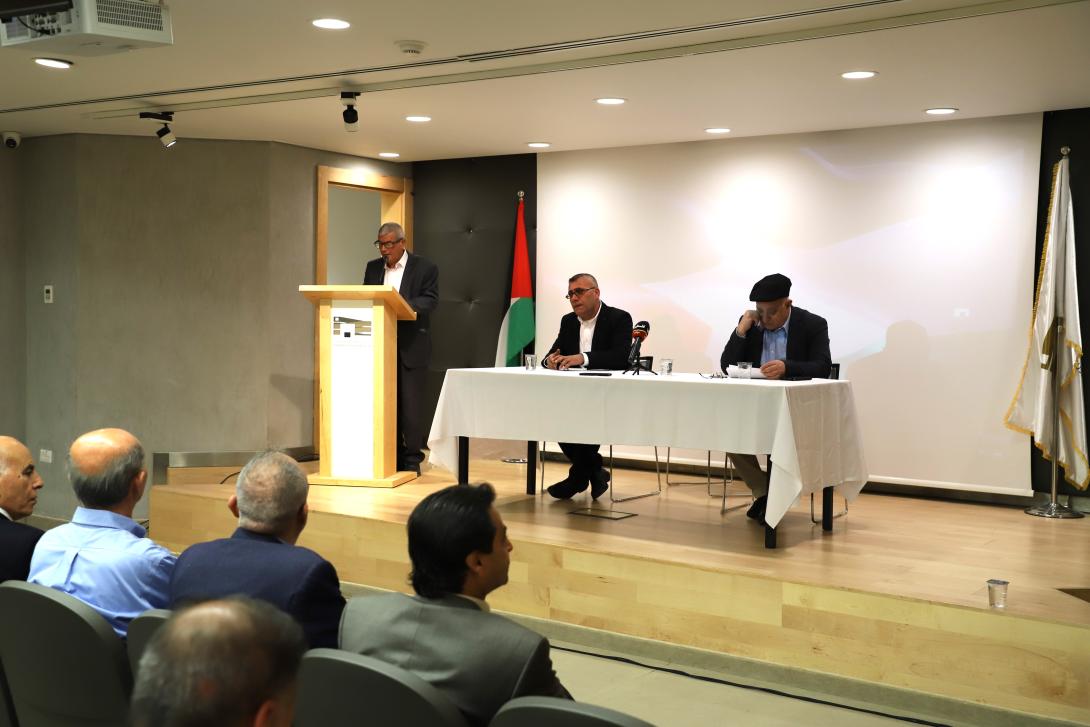
Ramallah - National Library: Yesterday, Wednesday, the National Library organized a symposium to announce its first publications “The Canaanite Linguistic Heritage of Palestine,” at Yasser Arafat Museum in Ramallah.
The event was attended by The head of the National Library, Issa Qaraqe, and the author of the book and the head of the Department of History and Archeology at Birzeit University, Dr. Issam Al-Halayqa, and the book’s editor and independent researcher in archaeology, Dr. Hamdan Taha, while it was moderated by Fawaz Salama, Director General of Archives at the National Library.
Qaraqe said that the National Library sees this book as an urgent need for the Palestinian library, schools, universities, researchers, and all Palestinian generations, therefore, it distributed it to all universities, public and private libraries, research centers, and those interested. He added “Although it appears to be a historical, cultural, and documentary book, it is a serious, professional, scientific, and academic attempt to liberate the Palestinian narrative from the grip and restrictions of Zionist and Orientalist studies.”
Qaraqe pointed out that this book collected dozens of Canaanite inscriptions and writings in Palestine and its surroundings since the nineteenth century BC, and included political, geographical, urban, economic, social, humanitarian and cultural analysis of this heritage and these Canaanite treasures in ancient historical times. In doing so, it confronts the Zionist ideology, its myths, legends, and its claims that the land of Palestine is the promised land, the land of the Torah, and the land of the fathers and grandfathers, indicating that the book stood in the face of the Israeli and Western archaeologists who sought to strip the Palestinians of their past, their historical identity, and their presence on this land in order to justify their colonization and settlement of Palestine, and the expulsion of its population.
In turn, Dr. Taha said that this book includes inscriptions discovered in the Land of Canaan and the neighboring and overlapping regions, in addition to the surrounding countries: Egypt, Syria and Iraq. He noted that the author of this book collected dozens of inscriptions and writings in the Canaanite, Akkadian, hieroglyphic, Phoenician, Hebrew, and Aramaic languages, covering a long period since the beginning of the alphabet from the ninth century BC until the sixth century BC, when the Aramaic language prevailed as an international language instead of the Canaanite language, adding that the inscriptions and writings varied between those engraved on huge edifices and rocks, statues, small stones, pottery vessels, pottery fragments, and bone and metal tools, in addition to seals, scarabs, and their impressions on clay, which They were used as official seals and bore the names of rulers, princes, merchants, and commoners.
He pointed out that these inscriptions and writings are considered primary sources for writing ancient history and rebuilding the ancient economic, social and political systems in Palestine, and provide important information about groups, peoples and social classes, the names of people and professions, agricultural tools and military tools, the names of goods and products, trade materials, literature, rituals, religious beliefs and ancient gods. These ancient inscriptions and writings also constitute an important material in studying the development of languages in Palestine, starting with pictographic, cuneiform, and alphabetic writing. Indicating that the study clearly showed that the land of Canaan is the land in which the Canaanite alphabet emerged, and how the first signs of the alphabet were found in Sinai, which is an area of major cultural contact between the Canaanite and Pharaonic civilizations, through the Canaanite miners who worked there, as evidenced by the inscriptions of Serabit el-Khadim and Wadi Abu Al-Hul.
While Dr. Halayqa reviewed the contents of the book, which came in (440) large pages, and consists of an introduction and seven chapters and is provided with a list of sources and references, pointing out that the first chapter includes a presentation of the nature of the writings discovered in Palestinian sites since the year 3100 BC. until the sixth century BC., which are cuneiform, hieroglyphs, and Canaanite. The most important of these inscriptions is the one that indicates the spread of the cuneiform writing tradition that began in northern Palestine and spread south to the city of Tal Balata, this inscription was discovered in Tal Balata and written by a Canaanite teacher complaining about not receiving his salary for three years.
As for the second chapter, it provides an overview of the development of Canaanite writing since it began in Egypt and Sinai, influenced by hieroglyphics, passing through three stages, the most prominent of which is pictorial, meaning writing physical objects vertically and horizontally. In the 14th century BC, these images were transformed into symbols, and in this way the Canaanites obtained a symbolic alphabetic writing, thus, this transformation is considered the most important cultural contribution that the Canaanites presented to the East region and to the entire world, as the Canaanite writing became the basis for all the alphabets currently existing in the East and in Europe.
The following chapters studied the Canaanite inscriptions in Palestine, the Canaanite seals and their prints, and the Canaanite city as a cultural framework for the Canaanite inscriptions in Palestine, in addition to the ethnic context of the Canaanite inscriptions in the second and first millennium BC. And the representation of the Canaanites in Egyptian fine art.

